—> If you value longform storytelling — with breath, history, and art at its core — consider becoming a paid subscriber to THIRD SPACE. You’ll get full access to exclusive performances and future writings rooted in Black imagination and archival reverence. Your support sustains this space — and makes the next one possible.
Zion lives in the in-between. In diaspora dreams, Zion is less a map dot than a spiritual THIRD SPACE – the hybrid realm where new identities bloom from old roots. A site of cultural hybridity, where multiple cultures intersect to create something novel. For those of us scattered by history, Zion is this creative in-between: a home we imagine and fashion through memory, faith, and art. It is the Africa of our ancestors and the new world of our rebirth, fused into one. In this THIRD SPACE, we carry Zion within us like a song, a secret meeting ground of then and now, here and there.
The Map is Not the Territory

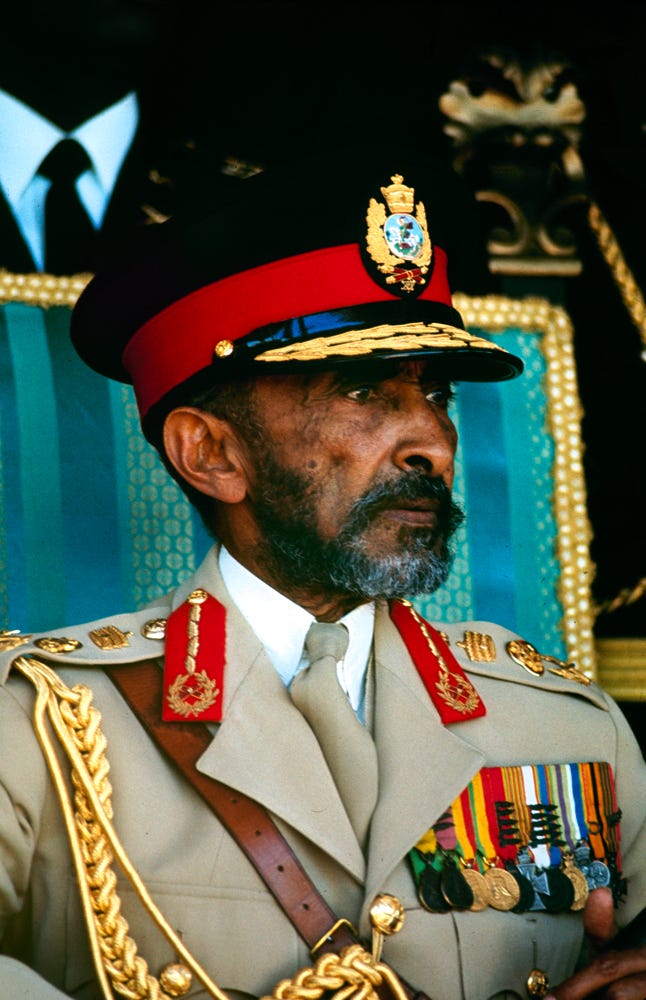
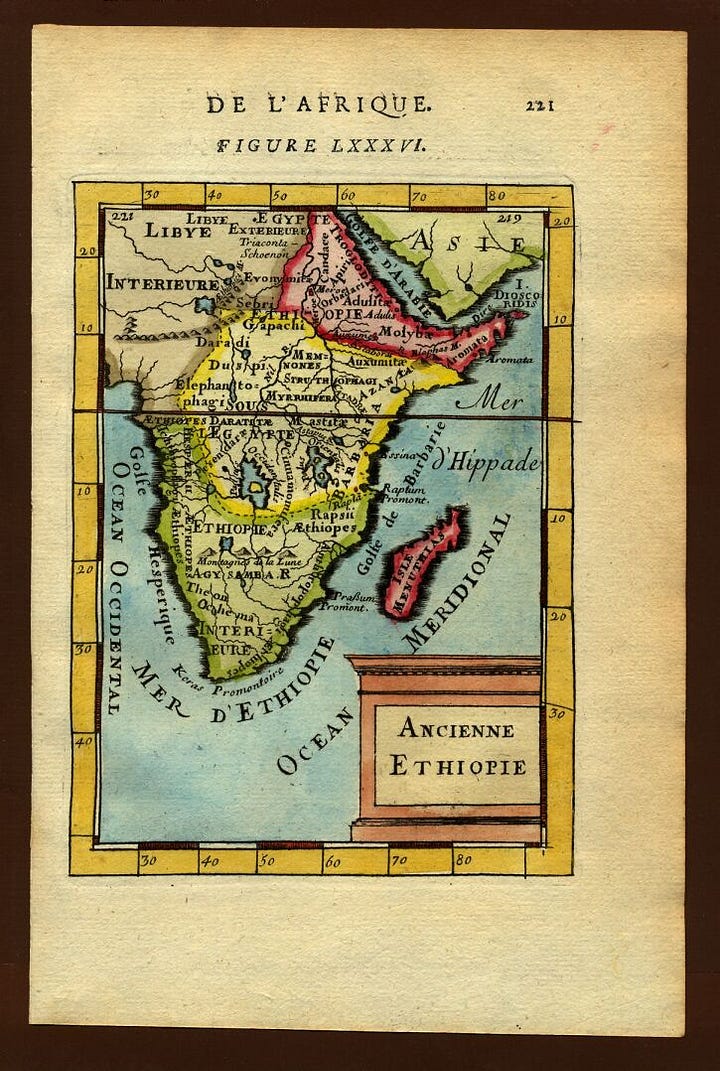

I think of Marcus Garvey, a Jamaican visionary in the 1920s, who urged us to “look to Africa.” Garvey foresaw a Black king rising in Africa to deliver his people. Indeed, in 1930, when Ras Tafari Makonnen was crowned Emperor Haile Selassie I of Ethiopia, Garvey’s followers exulted – prophecy fulfilled!
They hailed Selassie as Jah incarnate, the Messiah returned to redeem the African diaspora. Thus was born the Rastafari movement (named after Ras Tafari himself), a faith that cast Jamaica as Babylon—a land of exile and oppression—and Ethiopia as Zion—the Promised Land of liberation. In reggae mythology, Africa in general, and Ethiopia in particular, became the “Land of Zion” sung about in countless songs. Bob Marley’s voice echoes Garvey’s call: “We’re leaving Babylon, we’re going to our father’s land.” Those lyrics from Marley’s “Exodus” were more than a rhyme – they were a roadmap out of exile, a poetic compass pointing home to Zion.
“I am a people scorned,
A promise made on unseen shores,
A route weaved with tight sore fingers to a sunburned scalp.
My hair faced the new sun God,
My scourged back fruiting the apples.”
In my poem “Continental Crossings,” I channeled the ancestral voice of the Atlantic Crossing – the trauma and resilience of the Middle Passage. I wrote of an African Eve cast overboard yet seeding new worlds. Torn from a physical homeland, our forebears remade “home” as a feeling, a fervent hope. Uprooted, they cultivated Zion in the soil of imagination. Home is a feeling now. Ships were one way… we became the architects of your Project Nation. Building others’ empires with blood and prayer, they carried a stubborn belief that someday deliverance would come. Garvey gave that belief words; Selassie’s crowning gave it flesh. Zion took on an Ethiopian face.
In April 1966, history offered a glimpse of Zion on earth. Haile Selassie I, His Imperial Majesty – the Conquering Lion of Judah – stepped from his airplane onto Jamaican soil, and chaos nearly broke loose. Some 100,000 Rastafari from all corners of the island had flooded Kingston’s Palisadoes Airport, convinced they would behold their living God. A haze of smoke hung over the tarmac in a scene of biblical fervor.
When the Emperor’s plane arrived, delirious worshippers breached the security lines, swarming the aircraft and chanting “God is here!” as they reached to touch its gleaming sides. Selassie peered out at the sea of believers and, overcome by emotion, wept. Imagine it: the King of Kings standing at the top of the mobile stairs, tears in his eyes as he surveys the uncontrollable crowd that had come to welcome him home – for in their eyes, he was home, Zion embodied.
Eventually, the revered Rasta elder Ras Mortimer Planno was summoned onto the plane, emerging to plead with the throng: “The Emperor has instructed me to tell you to be calm. Step back and let the Emperor land.” Only then could Selassie set foot on Jamaican soil. April 21, 1966 – ever since celebrated by Rastafarians as Grounation Day – was a moment when the diasporic dream of Zion burst into technicolor reality. The scholarly might call it a “turning point,” , but for the faithful it was rapture. Many swear that rain stopped and the sun broke through as Jah descended from the sky that day, a blessing on the island.
Yet even in that exultant moment, Selassie gently reminded his flock of their duties back in Babylon. In a private meeting with Rasta elders, the Emperor urged them not to rush en masse to Ethiopia, but to “liberate Jamaica” first – a principle later coined “liberation before repatriation.” Zion was calling, yes, but not as an escape from the struggles at home. Freedom had to be planted in Kingston’s yards and gullies before it could flourish in African soil. Selassie did not rebuke the Rastafari for deifying him; in fact, he honored their faith by awarding gold medallions to their leaders. But he knew that Zion is a state of mind and justice, not just a destination on a map.
Still, Selassie had already opened a door for the African diaspora to physically return. Back in 1948, he granted 500 acres of his own land in a place called Shashamane to people of the West “who wanted to ‘come home.’” It was an invitation for exiles to make Ethiopia their Zion on earth. After the 1966 visit electrified Jamaica, small waves of Rastafarians sold their possessions and heeded the call. By the late 1960s, the Shashamane settlement – nicknamed “Little Jamaica” – sprang to life with dreadlocked repatriates farming Ethiopian soil. They were few but determined: by 2001 roughly 200 Rastafarian families were living there, carving out a utopia against the odds.
Political upheavals in Ethiopia (Selassie’s overthrow in 1974, hostile regimes afterward) reclaimed much of the land and stymied immigration, but a loyal community hung on. In truth, the grand Exodus that Marley prophesied – “the movement of Jah people” – never unfolded en masse. Zion in Shashamane became a modest camp instead of a nation. But its very existence is poetic: a quiet promise kept, an ancestral dream given flesh. A Rasta elder in Shashamane once said, “Many are called, few are chosen.” Those few hundred souls tilling the red earth of Oromia under the Ethiopian sun are living proof that Zion is not unreachable – it just asks for patience and sacrifice.
For me, a young woman of the African diaspora, these histories are not distant. They are the roots that hold up my own branches. Growing up, my mother – a Jamaican immigrant – made sure I felt those roots every day. While it’s hard for many to believe, my four best friends and I spent our early childhood memorizing Malcolm X’s speeches and Gwendolyn Brooks’ poems, practicing Yoruba sun salutations in morning yoga, and organizing canned food drives – all before we turned fourteen. This was in New Jersey, not Kingston or Kingston’s imagination. My mother co-founded a girls’ camp dedicated to cultivating exactly this: a life of Afrocentric art, truth, balance – the ancient principles of Ma’at – in modern Black girlhood.
Each summer we ended camp with performances of poetry and African dance, Jazz and hip-hop, complete with djembe drums and reggae bass. At five years old, I was taught to see my reflection in the Haitian Revolution, to find my voice in Nina Simone’s lyrics, to cherish my history as not just African or American, but both and more. I realize now how rare and beautiful that upbringing was. It shaped me into who I am: someone for whom diasporic consciousness is second nature, an inheritance to guard.
As I wrote in my program notes for the performance, my very presence at Harvard – studying sociology and African American studies – is “an act of reaffirming my deep belief and connection to justice and cultural preservation.” Each poem I write, each story I tell, is my way of tending the flame my mother lit – a flame passed down from Garvey and Marley, from Queen Nanny and Queen Sheba, from Addis Ababa to Montego Bay.
We Remember Forward
When I enrolled in Professor Monson’s course Pan-African Musical Connections (AFRAMER 142X), it felt like coming full circle. Here I was, diving academically into what my soul already knew: that music has been our diaspora’s truest archive and activist. For my final project in that course, I composed and performed two poems – “Continental Crossings” and “Sonic Heritage” – to trace the journey of Pan-African consciousness across continents and centuries. I spent weeks researching – rereading Henry Louis Gates on Haiti, Keisha N. Blain and Minkah Makalani on Garvey’s UNIA, studying Kongo spirituals – letting history guide my pen.
In “Sonic Heritage,” I even wove in Marcus Garvey’s own fiery words from a 1920s UNIA marching song:
“No cracker will dare seduce our sister, or to hang us on a limb… And we are not obliged to call him mister, or to skin our lips at him.”
Garvey’s defiant voice erupts in the middle of my poem – a reminder of the stark resolve early Pan-Africanists had against the Jim Crow world. I juxtaposed that with lines from surrealist poet Ted Joans and the uplift of Nikki Giovanni’s “Ego Tripping” to capture the evolving rhythm of liberation. The poems became time machines: we ride the Black Star Line, witness Sun Ra “blast us off to space” in an Afro-futurist reverie, hear James Brown shout “I’m Black and I’m Proud” as Brown v. Board cracks segregation. Each stanza was a portal to a moment where music and resistance intertwined.
I performed these poems live, heartbeat trembling, accompanied by an original score from a student composer, Toussaint Miller, with performers on piano, percussion, and trumpet. At first, I spoke over a hush, invoking ancestral voices from the Kongo to Reconstruction in near-silence, as if echoing in a cavern of time. Then, as I reached the birth of jazz in the poem, Miles Davis’s “So What” riff softly began, the trumpet and bass lifting my words about Harlem and Hughes into a jubilant swing. The effect was visceral.
As a guest lectur Professor Michael Veal had argued, the songs we absorb literally change us on a chemical level – music is embodied memory. And that day I felt it. I felt our audience lean in and travel with us. “I wanted the audience to feel transported to the mind of an African American through these critical centuries,” I wrote afterwards, “to feel the bouts of confidence, fear, conflict, and joy faced by these ancestors, and prove music’s ability to maintain their narratives even today.”
When I spoke the line “Higher than 125th Street, farther than Plessy, ‘the fatherland’ soon come, on a Black Star Line”, I could see heads nodding – history no longer in a textbook, but pulsing in the room. Poetry, music, movement: together they collapsed the distance between Jamaica and Ethiopia, between 1865 and 1965 and 2025. In those moments, Zion was not abstract. It was alive in our collective heartbeat.
—> Want to hear the full performance?
I’m sharing the complete video and both poems — “Continental Crossings” and “Sonic Heritage” — in a special bonus post just for paid subscribers.
My mother’s Jamaica was in the room too – in the rhythm of my words and the patois-inflected twang I couldn’t hide on certain rhymes. “My mom is a Jamaican immigrant, and both poems were deeply informed by the global Black history she infused throughout our community,” I had explained. Truly, I owe it to her that when I invoke Zion, I do so with an intimate reverence. From her I learned that cultural work – writing, singing, teaching – is sacred work. It’s how we water the seeds our ancestors planted. It’s how we keep Zion alive across oceans.
In an archival concert photograph, Bob Marley stands on stage in mid-trance, head flung back, dreadlocks flying like the mane of a lion. His guitar hangs from his shoulder as he lifts his voice to the heavens. The image freezes Marley in a posture of exaltation – knees bent, back arched, pouring every ounce of soul into a wail or a riff. You can sense the red-gold-green aura surrounding him. In that ecstatic pose, Marley looks like a man caught between worlds: here in the flesh, but channeling something ancestral, something divine. His eyes are shut tight, face contorted with emotion as if he might just levitate off the ground.
This is reggae’s high priest at work – a son of Jamaica invoking Ethiopia. Indeed, Marley often sang directly to Haile Selassie or about him, and onstage he was known to unfurl the Ethiopian flag or salute Selassie’s image. In the photo, though unseen, one can imagine a banner of Emperor Selassie hanging somewhere behind, watching over the performance. Marley’s concerts were more than entertainment; they were spiritual gatherings, “church” for the dislocated. The passion etched in his face and posture is the visual of Zion’s promise – a freedom reachable not by plane or ship, but by spirit.
As he once sang, “Old pirates, yes, they rob I… But my hand was made strong by the hand of the Almighty”, Marley embodied the belief that through music and faith, Babylon’s chains could be broken. The crowd in that moment undoubtedly felt it too – a collective transcendence, a taste of Zion, surging from the stage in waves of bass and drum. To see Marley performing is to witness diaspora in motion: African rhythms, European guitar, Caribbean heartbeat, all fused into a new, THIRD SPACE sound. His very image—dreadlocks, military-style jacket adorned with the Lion of Judah—was a walking synthesis of Jamaica and Ethiopia, rebellion and royalty. No wonder a Tuareg nomad in the Sahara once proudly played a Bob Marley ringtone on his phone for a traveler; Marley’s art made Zion portable, a vibration that could be carried anywhere from Kingston to Timbuktu.
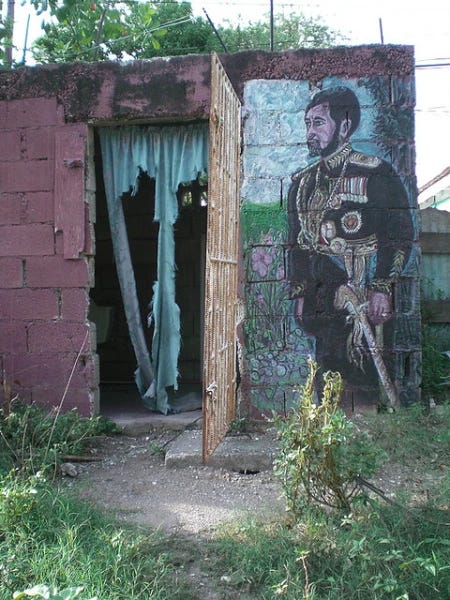
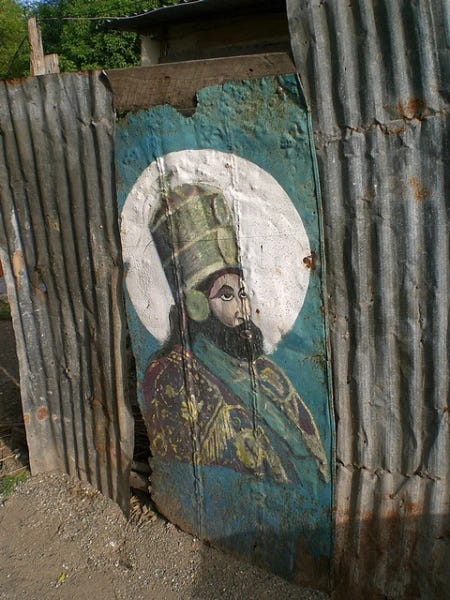
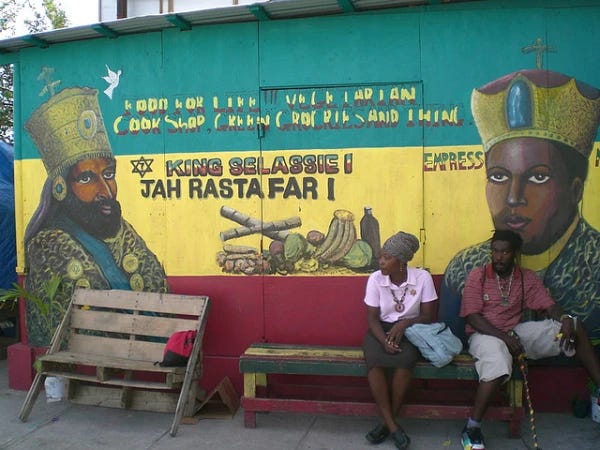
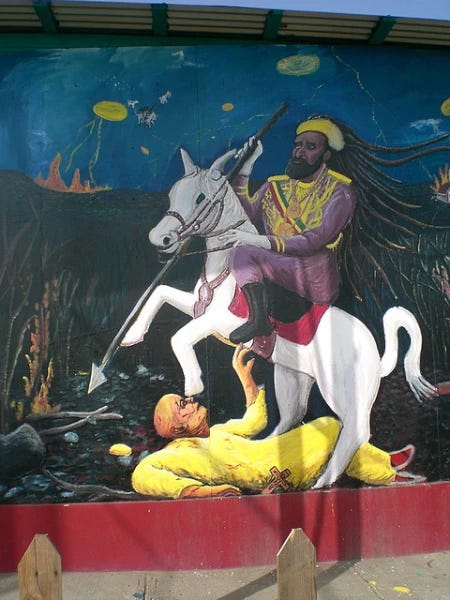
Visual icons have always bridged Jamaica and Ethiopia in the Rasta imagination. The same 1966 visit that brought the Emperor to Jamaica also left behind countless photographs and murals that still adorn Kingston’s streets. You can drive through the poorest yards in West Kingston and find lovingly painted portraits of Haile Selassie on cinderblock walls—the Emperor in his gold braided uniform, or rendered as a haloed saint, sometimes alongside images of Bob Marley or Marcus Garvey. These images are talismans of hope. One famous photo from 1966 shows Jamaican believers holding aloft a framed portrait of Selassie amid the airport crowd, literally raising their vision of Zion for all to see.
Such photographs became holy relics. Selassie’s visage, dignified and ancient, and Marley’s visage, radiant with contemporary rebel spirit – together they form a visual language of diasporic unity. One an emperor, one a musician, yet both lionized as freedom fighters in the pantheon of Black history.
If Marley and Selassie provided the spiritual and visual vocabulary of Zion in the 20th century, today a new artist carries that legacy in fresh forms. Gabrielle Tesfaye, a Milwaukee-born artist of Jamaican and Ethiopian parentage, creates multimedia art that feels like a continuation of that conversation across seas. Tesfaye is literally the child of this diaspora:
“My mother is from Jamaica and my father is from Tigray, Ethiopia,” she says. “Growing up as a first-generation American in the Midwest, I didn’t have many places to go to find a reflection of my cultural heritage. I began to study the art of my parents’ countries on my own. It became a tunnel to connecting with my roots… bridging it into my own work.”
Tesfaye speaks to what many of us “third culture kids” feel – “at times, I felt I wasn’t enough for either side… an internal and external struggle.” But rather than a deficit, that in-between identity became her superpower, fueling a truly hybrid creative vision.
In one of Tesfaye’s paintings, a colossal Black woman sits among mystic symbols. Her rich brown skin is inscribed with delicate filigree – patterns reminiscent of Ethiopian church art and sacred geometry. She extends one hand toward a radiant sun painted in gilt, while her voluminous hair billows into a cosmic storm cloud studded with constellations and ancestral faces. Beneath her, as if she is a sky-goddess grounding herself, are architectural forms in warm earthy tones: arches, gates, perhaps an echo of Lalibela’s churches or a Jamaican great house reimagined, all adorned with swirling vines and eyes that watch like guardians.
Tesfaye’s use of gold leaf and ink has a ritualistic quality – at once ancient (like the illuminated manuscripts of Ethiopia) and strikingly modern. The female figure’s gaze is steady, introspective, yet her scale is giant, suggesting a protective deity watching over scattered children. In this single frame, Tesfaye conjures a THIRD SPACE universe: Ethiopian hills rolling into Caribbean waves, African suns and diasporic moons sharing one sky. Her art is steeped in what she calls “ancient spirituality and contemporary social revolutionary ideas”, blending diasporic history with Afro-futurist imagination. As an interdisciplinary artist versed in painting, animation, and even puppetry, she brings stories to life in a way that feels ritualistic.
That same ethos drives The Water Will Carry Us Home (2018), a stop-motion ritual film where Tesfaye breathes life into ancestral spirits through handcrafted puppets. The story follows enslaved Africans thrown overboard during the Middle Passage—only to be met by Yoruba Orishas who rise from the sea to carry them home. Tesfaye transforms the Atlantic into sacred space. Her puppets do not merely perform—they resurrect. As she explains, she “uses the body in the form of mobile puppets, as a vessel to personify ancestral, emotional, and celestial ideas, transforming ancient symbolism into contemporary consciousness.” In Tesfaye’s hands, myth and memory merge into ritual cinema. The drowned are not forgotten—they are reanimated, held by waves, honored in motion.
The women in her paintings often bear swirling facial markings and wide, unflinching eyes, surrounded by motifs of Ethiopian Coptic crosses, Adinkra symbols, lotus flowers – symbols of many lands syncretized. Viewing her work, I feel the same stirring I do when listening to a great reggae track or reciting a Maya Angelou verse. It’s the feeling of diaspora spirits speaking. Tesfaye, like Marley, like Selassie, has become a keeper of Zion’s flame – except her altar is digital and her offerings are paint and pixels, poetry and motion.
Carrying Zion With Us
There is a moment near the end of my poem “Sonic Heritage” that I hold especially close. After journeying through slavery and jazz and civil rights in verse, I close with the words of Ted Joans – a Black surrealist who imagined an Afro-future beyond borders. Over a soft percussion, I recited:
“My future is your future / Your wounds are my wounds / The funky blues I cook are black like you – Africa.”
These lines hung in the air as the final note from the piano faded. My future is your future. Our destinies, as diasporic people, are entwined. We are each other’s harvest, each other’s business, as Gwendolyn Brooks wrote. Your wounds are my wounds – the injustice one of us faces is felt by us all, and the healing of one is hope for all. And that funky blues I cook are black like you – Africa: all our creativity, our art, our music, though born in exile, still tastes of home. Still carries the spice and soul of Mother Africa.
This is what Zion as a diasporic THIRD SPACE means to me. It means that whether we are in Trenchtown or Shashamane, Harlem or Harar, we carry an inner Zion that connects us. It’s in the way a reggae bass line mirrors an African nyabinghi drum; the way a Black Power protest in 1960s Kingston drew strength from a 1930s anti-colonial rally in Addis Ababa. It’s how I could grow up in New Jersey and yet feel Marcus Garvey and Haile Selassie guiding me as profoundly as any local history. In this THIRD SPACE, linear time dissolves; we coexist with our ancestors in a kind of sacred geography of the heart. The theory becomes flesh: diaspora identity is not half here, half there – it is a double presence, fully here and fully there, creating a new whole.
I end this lyrical journey not with an answer, but with a vision. Each name I’ve spoken—Garvey, Selassie, Marley, Tesfaye—is a ripple in the same ancestral tide. Their voices, like mine, hum inside the diaspora’s dream of return. In my performance, as my voice trembled with the weight of centuries, I realized: Zion is not a far-off holy land. It is the space we make sacred—together—when we choose to see one another across ocean and altar, across bassline and border. It is THIRD SPACE as sanctuary.
At the end of my performance, after Ted Joans’ words rang out, I stood in silence for a moment. I felt tears in my eyes that I hadn’t expected. They were not of sadness, nor simple joy – but of recognition. In the audience’s applause, in their faces (some smiling, some wiping away a tear of their own), I sensed that we had, together, touched Zion for an instant.
We had occupied that THIRD SPACE where the past and future meet, where Jamaica and Ethiopia dance, where pain turns into purpose and “wounds are our wounds” but so is triumph. The diaspora, scattered like stars, momentarily felt like a constellation again. And as I walked off the stage, I whispered a thank you to all those who lit the path – Garvey, Selassie, Marley, my mother, my ancestors – and to those, like Sister Tesfaye, who continue to light it anew. Our future is each other. Zion is here, now, whenever we make it so.
My future is your future… Black like you — Africa.
Until next time,
Marley
If this piece moved you, taught you something new, or reminded you of your own Zion…
Consider becoming a paid subscriber to THIRD SPACE — it helps keep this writing alive, ad-free, and accessible.
You can also buy me a coffee here ☕ to support the glue sticks, archival fees, and midnight edits it takes to bring these stories into the world.
Thank you always for reading, sharing, and dreaming alongside me.







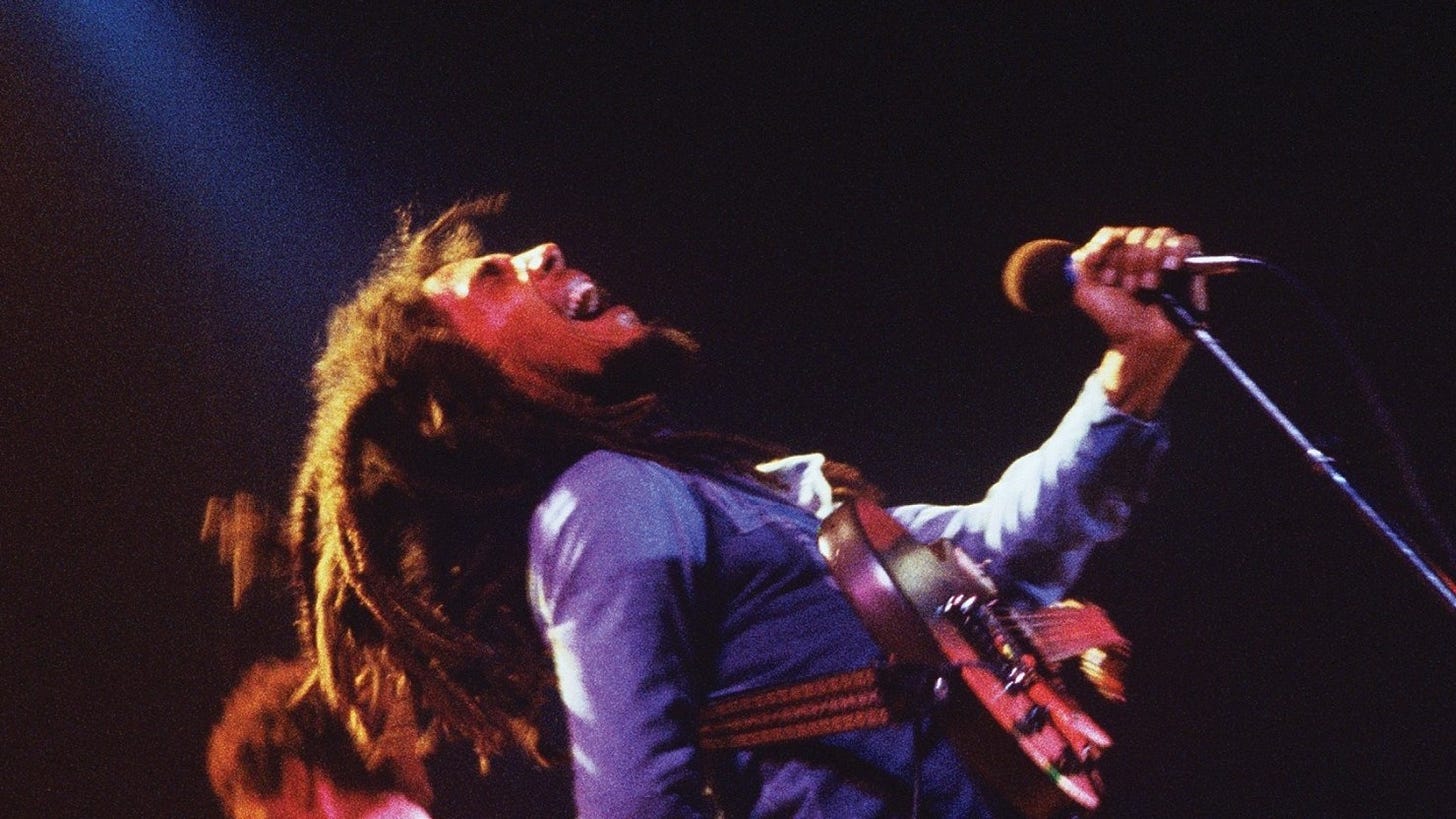


All of this!! Thank you!
Wow. This was an incredible read, and I learned a new perspective of history about which I knew nothing. I’m grateful to have stopped by.
Thank you for weaving this rich history into a legible tapestry for those of us who are unacquainted with its depth. I’ve seen this iconography for years and had no understanding of its symbolism.